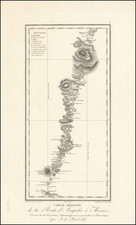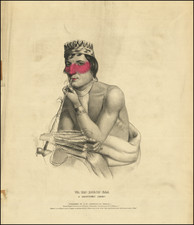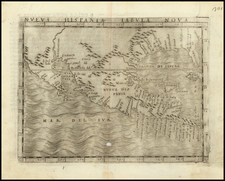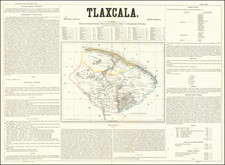Aztec Tribute Items: Military Vestments and Cotton Textiles
An original ink and watercolor drawing by Capt. William H. Shippard, showing a range of tribute items paid to the Aztecs, after the Codex Mendoza. The image shows 34 numbered figures representing both the tribute items themselves and the towns who contributed such items to the Aztecs.
According to a Metropolitan Museum (Met) exhibition description:
Throughout the fifteenth and early sixteenth centuries, the Aztecs were collecting large quantities of precious materials and luxury items as tribute from thirty-eight provinces spread across present-day Mexico. It was not until 1542, two decades after the Spanish conquered the Aztec Empire in 1521, that tlacuilos (Aztec scribes familiar with the indigenous pictographic system of writing) documented these earlier practices in a manuscript now called the Codex Mendoza.
Some of these tribute items are identified in a well known book by Francisco Antonio Lorenzana, Historia de Nueva-España, escrita por su Esclarecido Conquistador Hernan Cortes (Mexico, 1770):
- Figures 1-16 represent the towns who gave the tribute items. For example: 1) Colliman, 4) Tasco, 11) Huaxtepec.
- Figures 17-26 represent bundles comprising large quantities of cotton textiles (mantas, huipiles, most likely clothing for women)..
- Figures 27-34 are military vestments incorporating animal skins and featherwork.
Codex Mendoza
Among the most important of Mexican codices, the Codex Mendoza is a 16th-century Aztec document created around 1541. It is an informative compilation detailing the lineage of Aztec rulers and their conquests, alongside insights into the everyday life of the Aztecs before Spanish conquest. Written in Aztec pictograms, it also includes Spanish translations and annotations. The document is named after the first viceroy of New Spain, Don Antonio de Mendoza, who oversaw its creation and was a significant patron of indigenous artistry.
Now housed at the Bodleian Library in England, the Codex Mendoza details the establishment of Tenochtitlan. It is a screenfold book made of bark paper and uses the Aztec script, with dimensions of 140 by 23.5 cm. Mendoza commissioned this document, recognizing the loss of Indigenous artifacts and traditions following the Spanish conquest. He organized a workshop where native artists and scribes, under Spanish ecclesiastical guidance, could replicate these works.
The document, also known as the Codex Mendocino and La Colección Mendoza, has been part of the Bodleian Library since 1659 and was featured in an exhibition there in 2023. The Bodleian holds several other Mesoamerican manuscripts.
The codex's production likely took place between 1529 and 1553. The manuscript's hurried completion is noted on its final page, which apologizes for the unrefined interpretation of the pictograms due to time constraints. Controversy surrounds the precise dating and purpose of the manuscript, with various historical accounts contributing to the debate.
This important codex, largely unnoticed until rediscovered in the 19th century, serves as a key historical source for understanding Aztec civilization and the early period of Spanish rule in the New World.
A note in Shippard's distinctive hand appears in the lower margin:
Mexican tribute Roll from page 22 of the 1st part of the Mendoza Collection in Aglio vol. 1. list in [?] the Lorenzana Collection.
William Henry Shippard's Mexican Paintings
William H. Shippard (1803-1865) was a pioneering 19th-century British museologist - an unsung progenitor of modern-day museum anthropology. While he is chiefly remembered as a friend of George Catlin, Shippard's profound interest in the ancient civilizations of Mexico connects him with a cohort of British contemporaries that include Lord Kingsborough and the showman William Bullock. Shippard's fascination with Mesoamerica propelled him to amass a significant collection of visual material derived from Aztec codices which he copied himself. A figure of some intrigue and scholarly ambition, Shippard endeavored to establish the Museum of Mankind in London, which seems to have evolved from his deep interest in early Mexican cultures. Although the museum did not come to fruition, Shippard's original artwork, mainly pen and ink drawings enriched with vibrant hand coloring, based on Mexican codices held in European libraries and collections, remains a valuable historical source, particularly for understanding the allure of Mexican antiquity within early 19th-century British collecting circles.
Capt. William H. Shippard, a friend of George Catlin and an avid watercolorist and museologist, was also a pioneering British Mesoamericanist. Shippard appears in British newspaper notices from the 1840s as a London-based lecturer who spoke about Native Americans and Mexican antiquities. We know he was a friend of George Catlin, and that he was involved in attempts to organize early London museum exhibitions of Mexican antiquities. In the latter efforts Shippard would seem to coincide with a group of like minded prominent English collectors interested in Mexican topics active during the 1820s and 1830s, including Lord Kingsborough and the bibliomaniac Sir Thomas Phillipps, among others. He seems to have been an armchair anthropologist and would-be museum founder, whose ambitious ideas for a London-based museum never got off the ground - at least not beyond the prospectus-printing stage. Certain aspects of Shippard's career are akin to William Bullock, the showman and connoisseur of Mexican antiquities who actually did travel to Mexico. Bullock published a notable book about his Mexican travels, and achieved a level of recognition in his day as the empresario of London's Egyptian Hall, wherein he thrilled large London audiences with his elaborate exhibitions of exotica, including Mexican items.












![(Second French Intervention in Mexico - Manuscript Map) Michoacan [and parts of Guanajuato and the Bajío region of Mexico]](https://storage.googleapis.com/raremaps/img/small/86018.jpg)
![[Arizona below New Mexico] Mexique d'apres le grand Atlas Dresse Par A.H. Dufour Grave par ch Dyonet Pubie par A. Le Chevalier . . . 1863](https://storage.googleapis.com/raremaps/img/small/64395.jpg)
